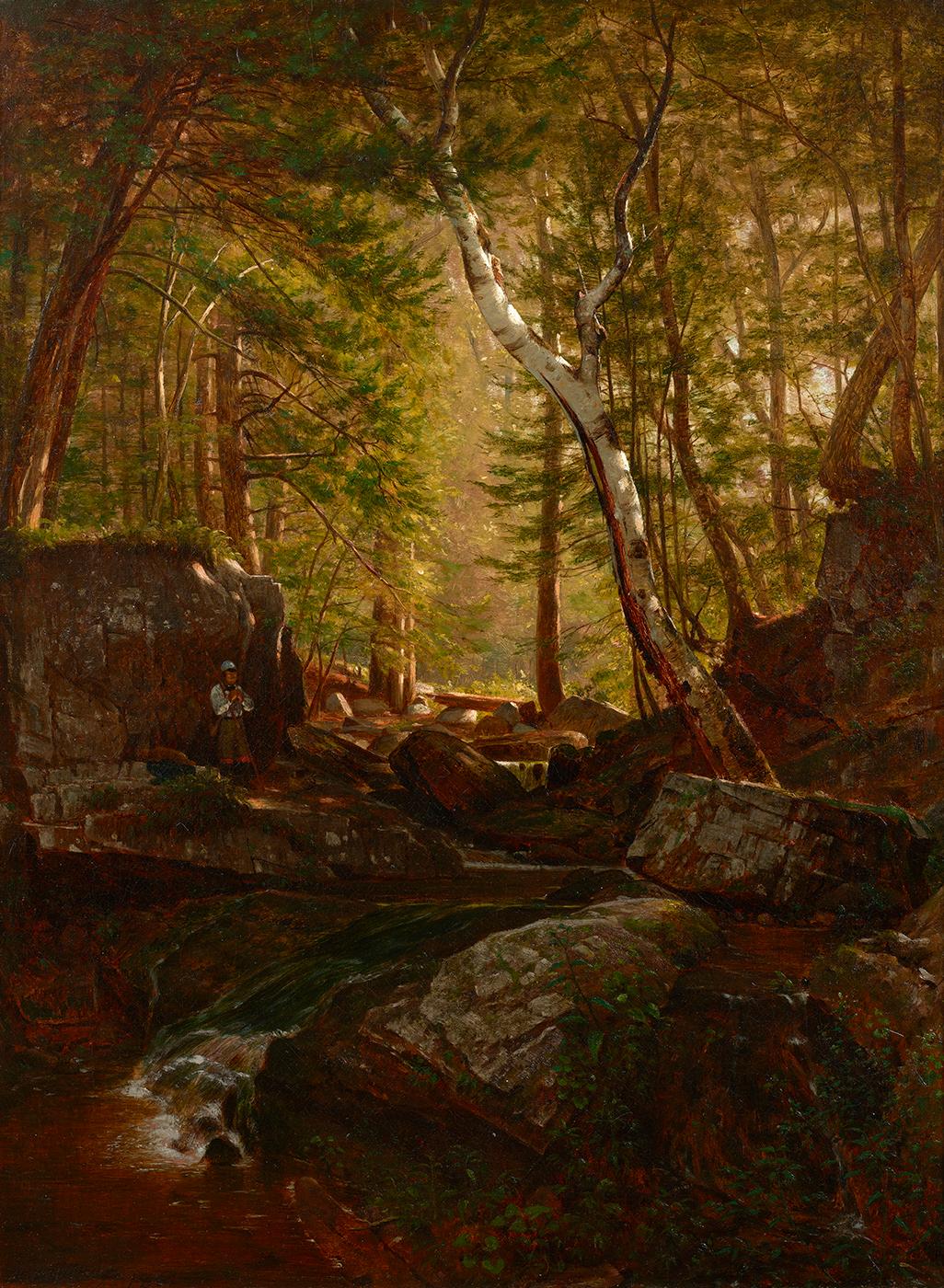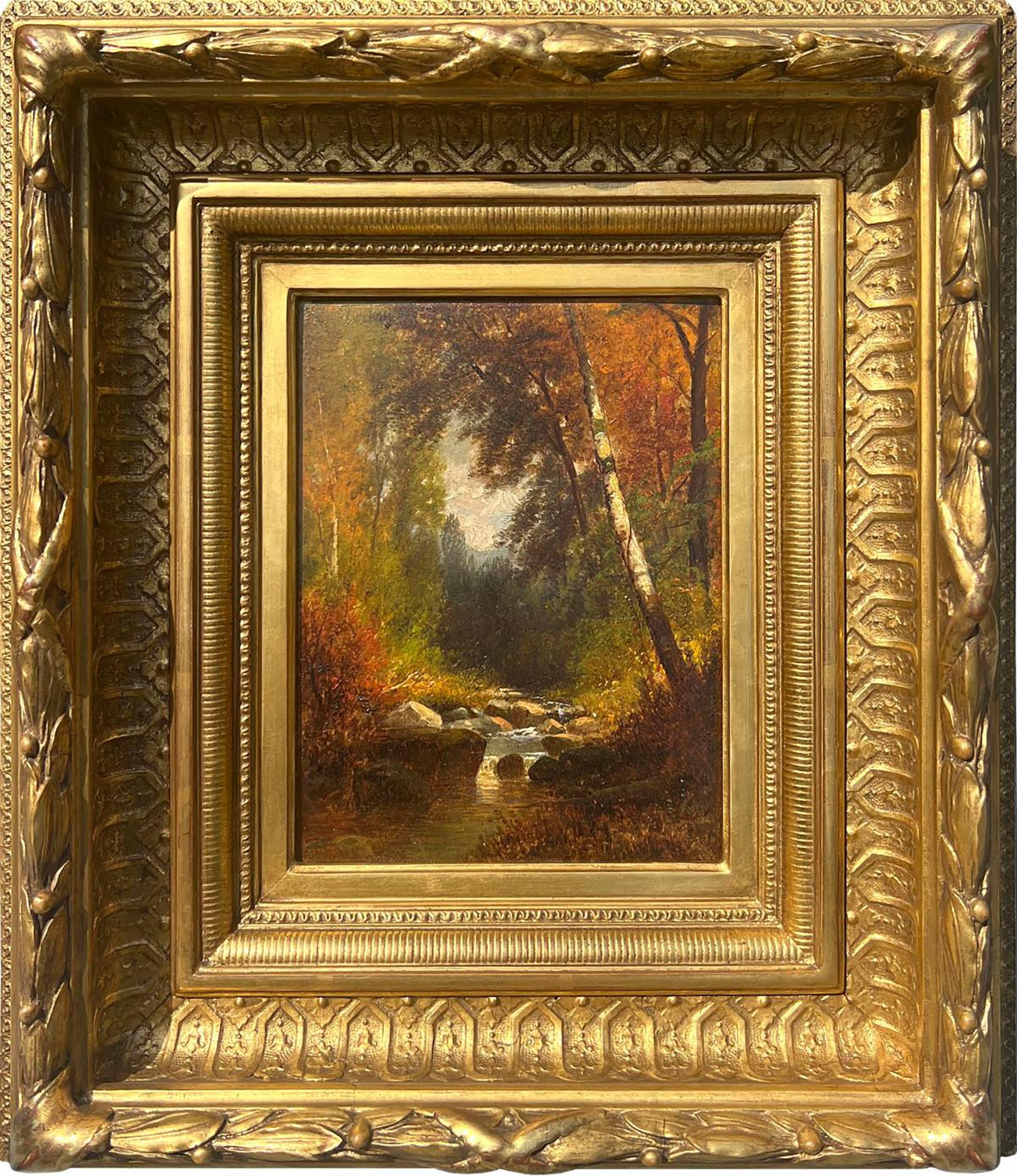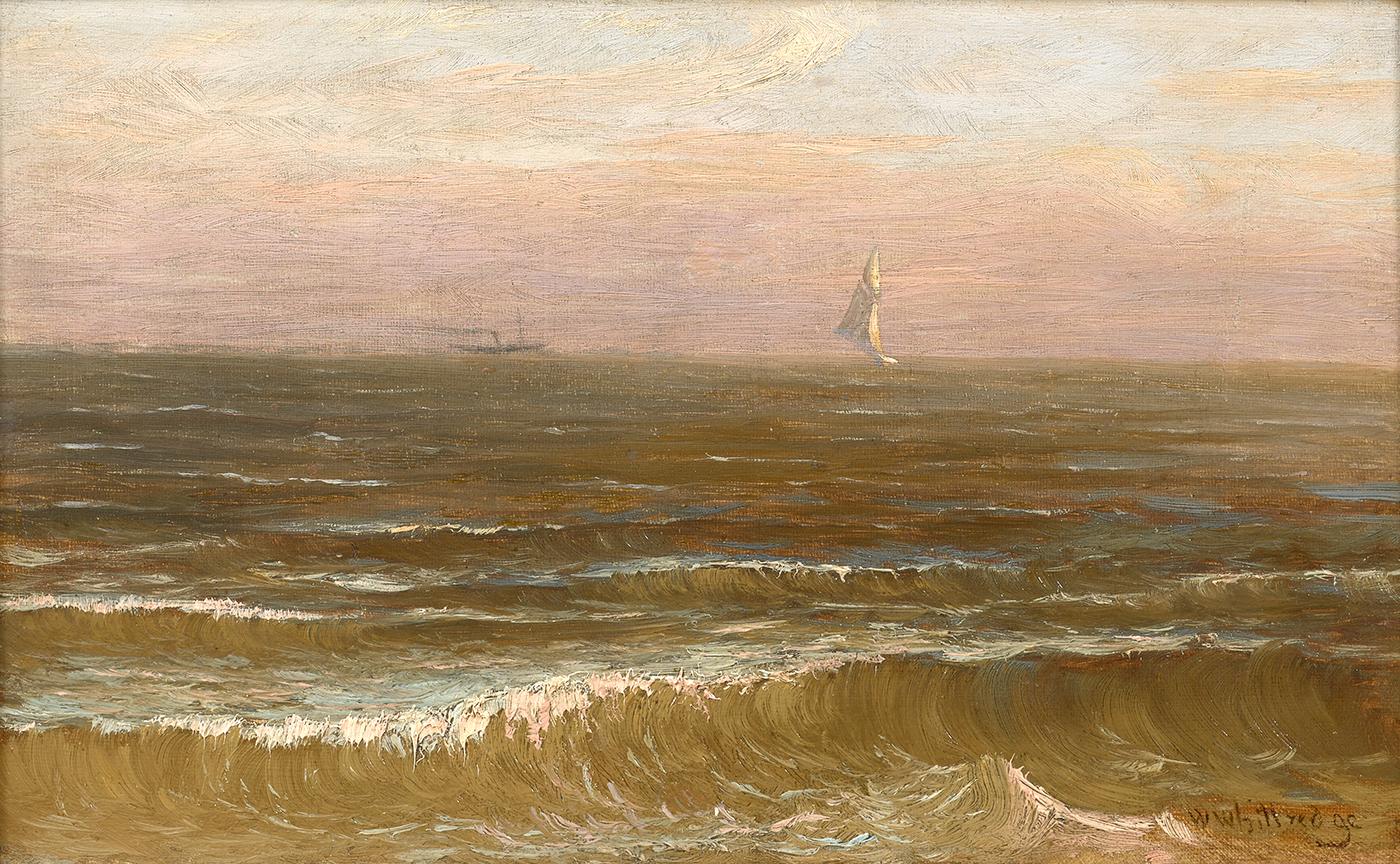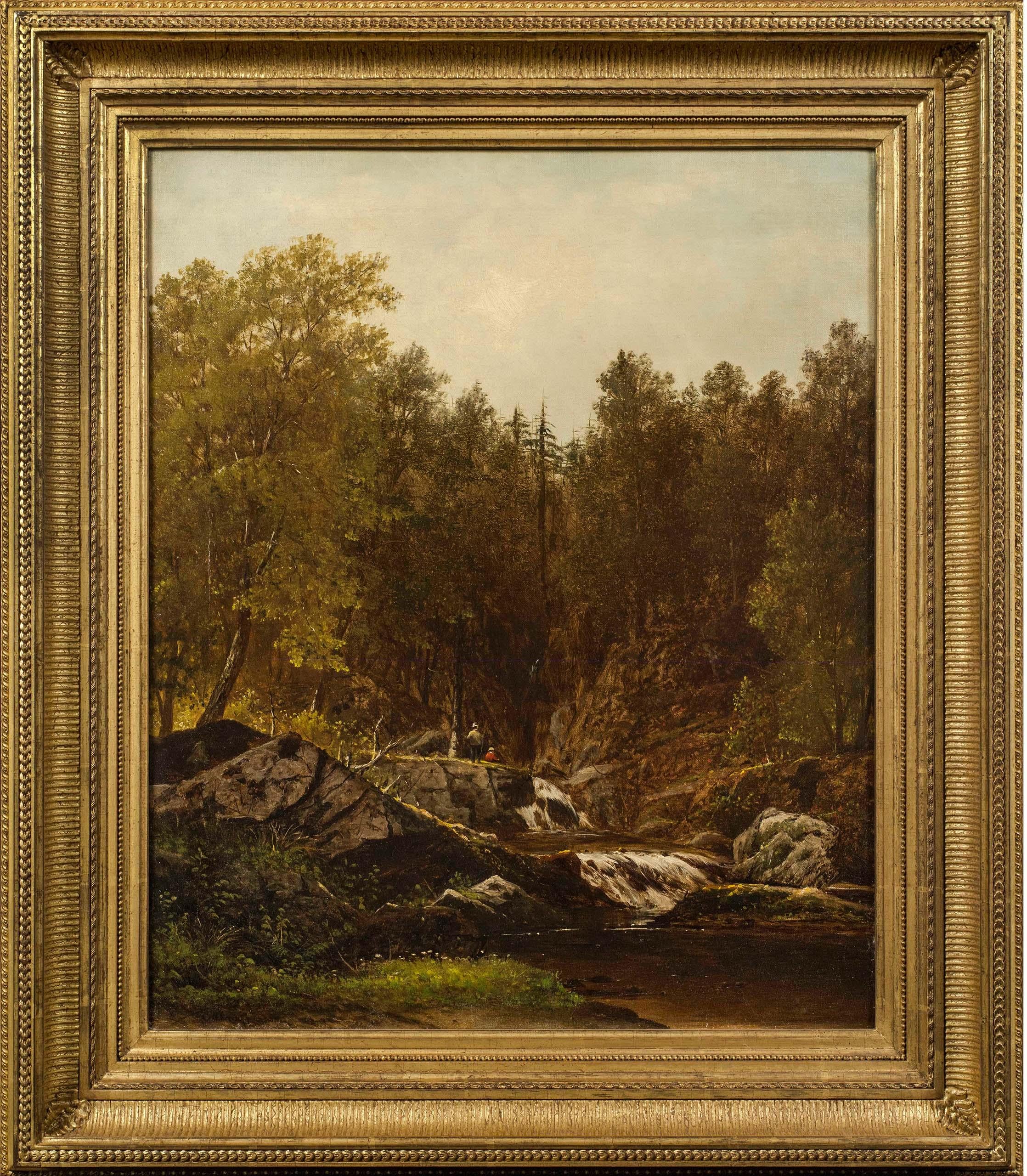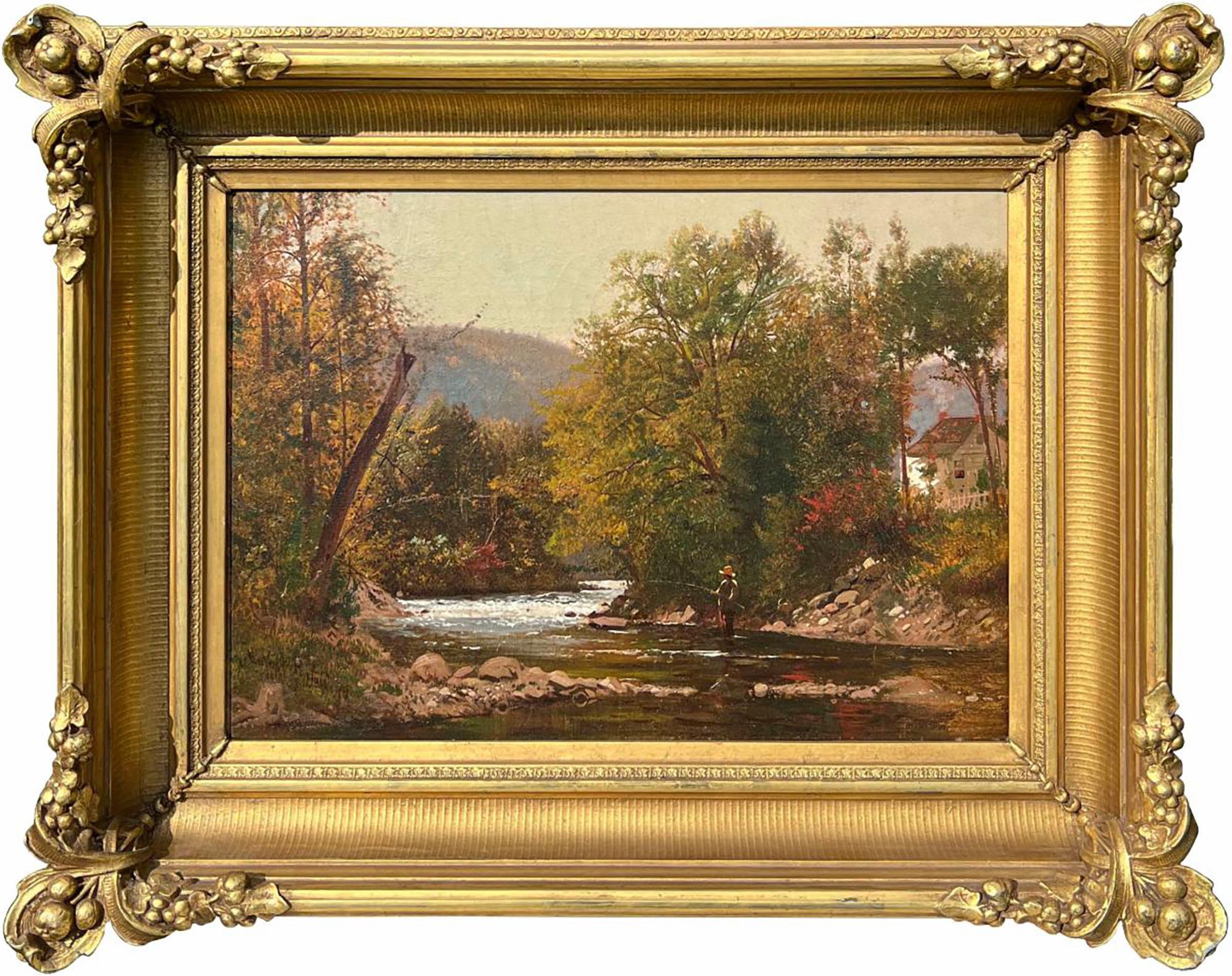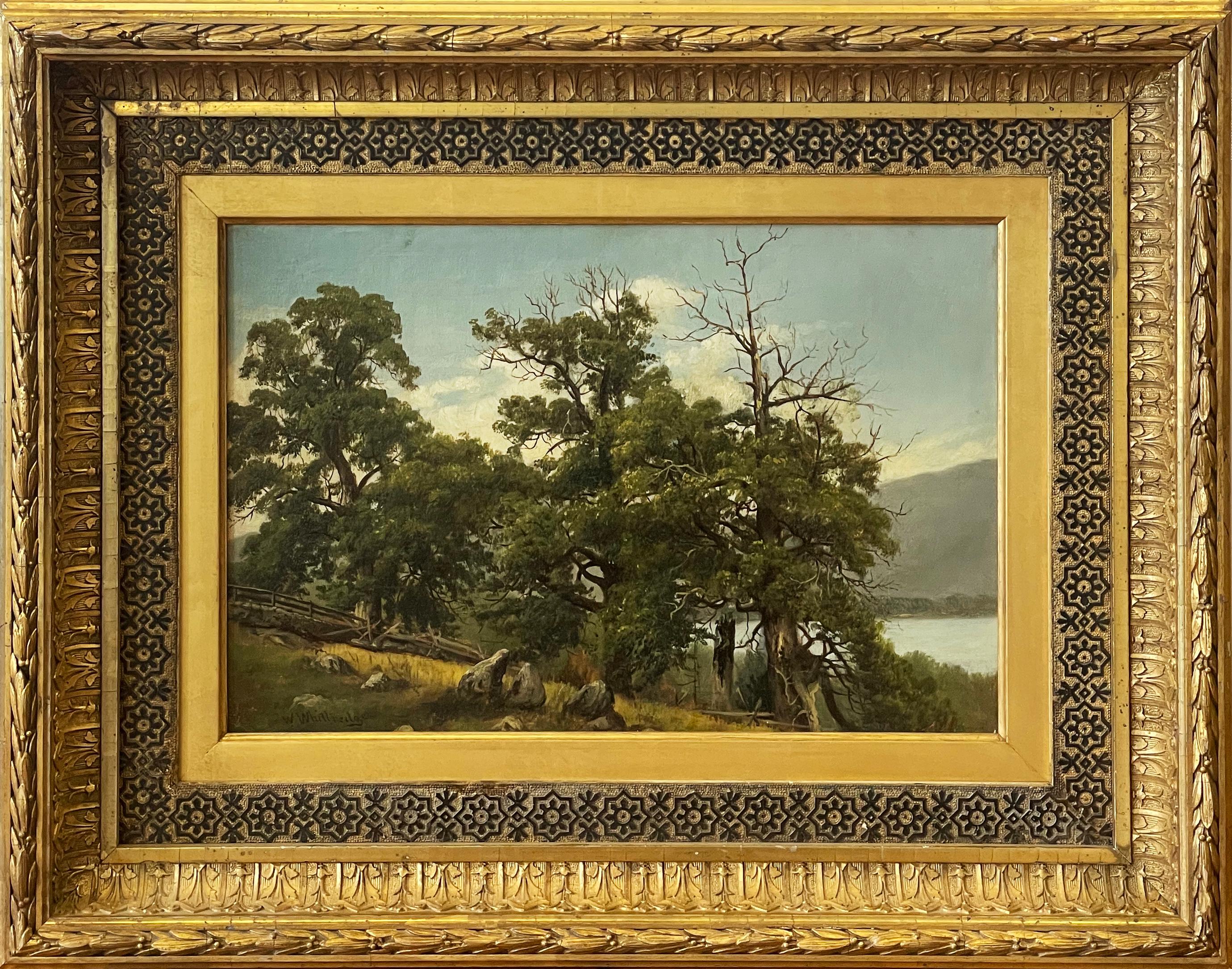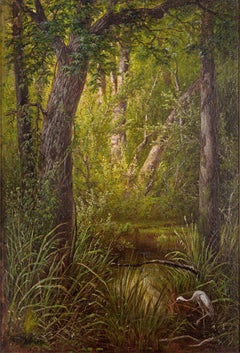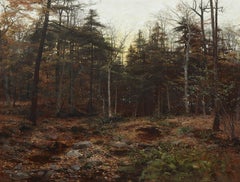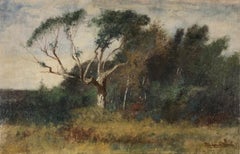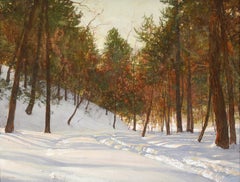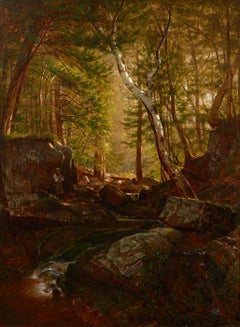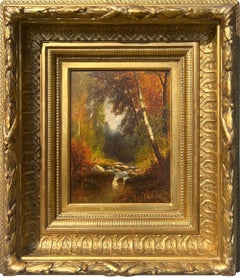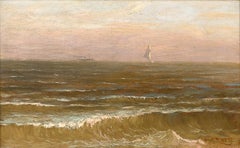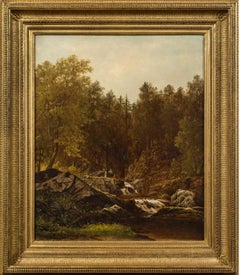Items Similar to The Trout Pool
Want more images or videos?
Request additional images or videos from the seller
1 of 9
Worthington WhittredgeThe Trout Poolc. 1870
c. 1870
$52,000
$65,00020% Off
£39,405.01
£49,256.2620% Off
€45,409.72
€56,762.1520% Off
CA$73,542.35
CA$91,927.9320% Off
A$79,088.63
A$98,860.7920% Off
CHF 42,288.85
CHF 52,861.0620% Off
MX$953,786.44
MX$1,192,233.0520% Off
NOK 534,771.40
NOK 668,464.2520% Off
SEK 487,245.60
SEK 609,056.9920% Off
DKK 339,311.25
DKK 424,139.0720% Off
About the Item
Provenance
Collection of Mrs. Victor R. Bieber, Gwynedd, Pennsylvania
Born in Ohio, Worthington Thomas Whittredge began his career as a sign and portrait painter in Cincinnati, where he attracted the attention of local patrons whose support enabled him to travel abroad. After a decade of study in Europe, he returned to the United States in 1859, settling in New York City to pursue landscape painting. He rented a studio in the new Tenth Street Studio Building, where Frederick Church, Sanford Gifford, and other leading painters were already in residence. Whittredge managed to have four of his European paintings accepted for the National Academy of Design’s exhibition in the spring of 1860, but he realized that to succeed he would need to produce something new and which might claim to be inspired by his home surroundings. He had recognized that the success of the Hudson River School was due largely to the way its native subject matter gave pictorial expression to strong currents of American nationalism and pride. And he knew, too, that his own art was still so much under the spell of Europe that he needed an aesthetic jolt of fresh inspiration. So, like Thomas Cole thirty-five years before him, Whittredge went to the first available outdoor place he could find, the Catskills.
The scenery Whittredge found in the Catskills surprised him greatly: “But how different was the scene before me from anything I had been looking at for many years! The forest was a mass of decaying logs and tangled brushwood, no peasants to pick up every vestige of fallen sticks to burn in their miserable huts, no well-ordered forests, nothing but the primitive woods with their solemn silence reigning everywhere. I think I can say that I was not the first or by any means the only painter of our country who has returned after a long visit abroad and not encountered the same difficulties in tackling home subjects.” Gradually, Whittredge came to term with his new subject, while still maintaining a firm grasp on the painting techniques he had learned in Europe. He started sending American scenes to the Academy exhibitions and received high praise. His style was at once meticulous in its delineation of the intricate forms of the forest and remarkably assured in its fluent brushwork. Whittredge’s years of study in Europe (especially in Dusseldorf) had taught him that the actual appearance of nature could be portrayed through means other than the literal, precise brushwork often favored by his colleagues. He knew that sometimes more could be achieved by suggesting, rather than simply mimicking, the facts of external reality. Whittredge had managed to bring a new vitality to the American landscape. None of his contemporaries would be so successful in melding the sophisticated lessons of European painting with the nationalist aspiration and religious associations that had become endowed in the American landscape itself.
This work is a smaller version of a painting of same title at The Metropolitan Museum of Art. Whittredge would paint the large version of a subject and then exhibit those works at the National Academy of Design in New York. When a client would see the painting on exhibit, they would sometimes ask Whittredge to paint a smaller version, and this painting is one of those examples. It is exactly one-half the size of the Met's painting, but otherwise it is exactly the same.
Likely a landscape in the Catskills, the painting reveals the influence of Asher B. Durand; however, Whittredge used a masterful blend of light and shadow, detail and painterliness to emphasize nature's expressive qualities, in particular what made the American landscape extraordinary.
- Creator:Worthington Whittredge (1820 - 1910, American)
- Creation Year:c. 1870
- Dimensions:Height: 15.38 in (39.07 cm)Width: 12.75 in (32.39 cm)
- Medium:
- Movement & Style:
- Period:
- Condition:Very good condition. The canvas is lined and has been recently cleaned. There is a very fine network of hairline inpaint in the center of the canvas to repair a horizontal and vertical tear.
- Gallery Location:Bryn Mawr, PA
- Reference Number:1stDibs: LU2773216166602
About the Seller
5.0
Recognized Seller
These prestigious sellers are industry leaders and represent the highest echelon for item quality and design.
Established in 2001
1stDibs seller since 2024
7 sales on 1stDibs
Typical response time: 1 hour
- ShippingRetrieving quote...Shipping from: Bryn Mawr, PA
- Return Policy
More From This Seller
View AllWoodland Interior
By William Trost Richards
Located in Bryn Mawr, PA
Woodland Interior
Oil on canvas
21 7/8 x 14 3/4 inches (55.6 x 37.5 cm)
Framed dimensions: 32 7/8 x 26 inches
Signed lower left: Wm. T. Richards
Provenance
The artist;
James Bayard ...
Category
Mid-19th Century Pre-Raphaelite Landscape Paintings
Materials
Canvas, Oil
Woodland Scene
By William Bliss Baker
Located in Bryn Mawr, PA
Woodland Scene, 1885
Oil on canvas, 38 x 50 inches (96.5 x 127 cm)
Framed dimensions: 49 3/8 x 61 3/8 inches
Signed and dated lower left: W Bliss Baker 1885
Provenance
Albert E Clue...
Category
1880s Hudson River School Landscape Paintings
Materials
Canvas, Oil
The Edge of the Forest
By Robert Swain Gifford
Located in Bryn Mawr, PA
Robert Swain Gifford (1840–1905)
The Edge of the Forest
Oil on canvas, 15 x 23 1/4 inches (38.1 x 59.1 cm)
Estate stamp lower right: RSwain Gifford
Provenance
The artist;
By descent in the family to the artist's great-grandaughter, until 2023
Born on a small island near Martha's Vineyard, R. Swain Gifford and his family moved to the New Bedford, Massachusetts, area when he was two years old. The Dutch marine painter Albert Van Beest arrived in New Bedford in 1854, providing the teenage Gifford with the opportunity of study; he collaborated with Van Beest on a number of ship pictures...
Category
19th Century Tonalist Landscape Paintings
Materials
Oil
Bars of Light
By Walter Launt Palmer
Located in Bryn Mawr, PA
Walter Launt Palmer is best known as “the painter of the American Winter.” In Bars of Light, the cool areas of shade haphazardly crisscross and then blanket the warm sunlight on the ...
Category
Early 1900s American Impressionist Landscape Paintings
Materials
Watercolor, Gouache
New England Farmhouse
By Robert Swain Gifford
Located in Bryn Mawr, PA
Provenance
The artist;
By descent in the family to the artist's great-grandaughter, until 2023
Born on a small island near Martha's Vineyard, R. Swain Gifford and his family moved t...
Category
Late 19th Century Barbizon School Landscape Paintings
Materials
Canvas, Oil
Tropical Landscape
By Norton Bush
Located in Bryn Mawr, PA
Norton Bush (1834-1894)
Tropical Landscape
Oil on board, 8 3/4 x 11 3/4 inches (22.2 x 29.8 cm)
Signed lower left: N. Bush
Provenance
Private collection, New York;
Private collection, Pennsylvania
First noted for his portraits, marine views, and East Coast landscapes, Norton Bush became best known for his tropical views of Central and South America. He studied in New York City with the Hudson River school painter Jasper Cropsey and received criticism from another Hudson River school painter, Frederic Edwin Church. Like many who worked in the Hudson River school style, Bush also sought to inspire viewers with an expansive view of nature that dwarfed the relative influence and position of man. He first became interested in painting exotic...
Category
19th Century Hudson River School Landscape Paintings
Materials
Oil
You May Also Like
Trout Fisherman in a Mountain Stream
By Worthington Whittredge
Located in New York, NY
Signed and dated lower left: W. Whittredge 1861
Category
19th Century Hudson River School Landscape Paintings
Materials
Oil
Adirondack Stream by Hudson River artist Joseph Antonio Hekking (1830-1903)
By Joseph Antonio Hekking
Located in New York, NY
Painted by Hudson River School artist Joseph Antonio Hekking (1830-1903), "Adirondack Stream in Fall" is oil on board and measures 8.5 x 6.5 inches. The painting is signed at the low...
Category
19th Century Hudson River School Landscape Paintings
Materials
Oil, Board
Homeward Bound
By Worthington Whittredge
Located in New York, NY
Signed lower right: W Whittredge
Category
19th Century Hudson River School Landscape Paintings
Materials
Oil
Fishermen by a Brook by Charles Wilson Knapp (American, 1823-1900)
By Charles Wilson Knapp
Located in New York, NY
Hudson River School artist Charles Wilson Knapp's (1823-1900) "Fisherman by a Brook" is oil on canvas and measures 24 x 20 inches. The work is signed by Knapp at the lower left. The ...
Category
19th Century Hudson River School Landscape Paintings
Materials
Canvas, Oil
Trout Fishing, 1871 by Hudson River School artist Ernest Parton (1845-1933)
By Ernest Parton
Located in New York, NY
Hudson River School artist Ernest Parton's (1845-1933) "Trout Fishing," is oil on canvas, measures 11.25 x 15.75 inches, and is signed and dated 1871 at the lower left. The work is f...
Category
19th Century Hudson River School Landscape Paintings
Materials
Canvas, Oil
Tree Study, Lake George
By Worthington Whittredge
Located in New York, NY
A remarkably fresh, naturalistic and rare depiction of the environs of Lake George!
It is possibly from the late 1860’s, after the Civil War when his work became more naturalist in m...
Category
Mid-19th Century Hudson River School Landscape Paintings
Materials
Canvas, Oil
More Ways To Browse
Antique Hut
Antique Trout
Brown Trout
Oil Painting Trout
Asher B Durand
Greenwich London
H Mary
Ibiza Painting
Japanese Garden Painting
Jenkins Oil Painting
Landscape Painting By W Hampton
Large British Painting Modern
Mid Century Tropical Art
Oil Painting Richmond
Oil Paintings Of Homes
Old Masters Venice
Painting California Hills
Painting Switzerland Lake
